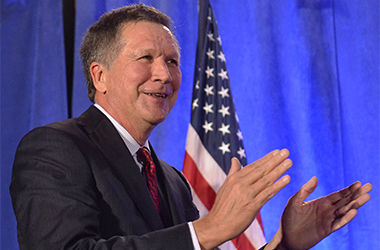State recap: Republicans dominate Ohio
November 5, 2014
The political landscape of Ohio’s legislature changed from blue to red as Ohio Republicans took all of the top spots within the state government.
“This is not your old man’s Ohio anymore,” Governor John Kasich said in his victory speech Tuesday night. “It’s a new, a bold, and exciting state. We are having magic in Ohio. We’re only in halftime, as they like to say, and we will continue to do our best.”
Kasich pumped his fists in the air to AC/DC’s “Thunderstruck” as he sauntered onto the ballroom stage.
Inside the Renaissance Hotel in downtown Columbus, a crowd of Republican supporters cheered as each race was called, holding glasses of champagne and bottles of beer in the air. When a message from the conceding Democratic gubernatorial candidate Edward FitzGerald projected on the wall, several booed while others laughed at his comments.
In his concession speech, FitzGerald said that the campaign ideals that he and his supporters have need to continue despite defeat in this campaign.
“It’s really important that those convictions that I have and that you have survive this campaign,” he said. “We believe in things and you have to fight for them regardless of the outcome of these campaigns.”
The race for Ohio Governor was the first state race called as Kasich and Lt. Governor Mary Taylor took the office with a 32 percent lead over Democratic opponent FitzGerald. Just after polls closed at 7:30 p.m. in Ohio, the Associated Press and several Ohio-based news outlets, including the Columbus Dispatch, declared Kasich the overwhelming victor.
Following Kasich were the races of Mike DeWine, re-elected as Ohio Attorney General; Dave Yost, re-elected for
Auditor of State; Jon Husted, re-elected as Secretary of State; and in the closest race of the night, Josh Mandel was re-elected to State Treasurer with 57 percent of the vote.
“We’re going to make Ohio the greatest state in the nation,” Husted told the crowd of supporters.
Incoming Kent State students can look ahead to the campaign promises and candidates’ proposed policy changes that will affect higher education.
In June, Kasich signed House Bill 487, which includes a provision that makes it easier to gain college credit while still in high school, something Kasich said will keep college costs down.
“One of the worst things you can do is you go to school, you’re lost, you never get a degree, you ring up debt and you have nothing to show for it,” Kasich said in an interview with The Columbus Dispatch. “We changed all of that. Now, if you go to school, they have all the incentives in the world to produce at graduation.”
Safety was one of DeWine’s major initiatives during his first term in office. DeWine worked to reduce the amount of backlogged rape kits in the state, convicting thousands of criminals in the process. With campus sexual assaults on the rise and an awareness of rape culture that has risen on college campuses, DeWine’s policies could affect the safety of Kent State students and residents of Portage County.
“I’m excited about the future and what lies ahead,” DeWine said, noting that with four more years he would continue his fight to bring justice to rape victims.
Both Kasich and Mandel said during their campaigns that they connected with young voters, especially students, and would work to eliminate student loan debt without increasing fees. Kent State President Beverly Warren recently said she is against any increase in the credit hour or other fees that would make attending Kent State more difficult.
Auditor Dave Yost told the crowd on election night about how far the state of Ohio has come with Kasich in office. He compared the social, economic and political affairs of the state as a dark hole left over from previous governors policies.
“For the past four years we’ve measured our progress from how far we’ve come,” Yost said in his victory speech. “That way of thinking ends tonight; that moment is history.”
In the state congress, Republicans won 63 of 99 districts for the State House of Representatives and 10 of 17 seats in the State Senate.
Ohio voters also elected 12 of 16 Republican U.S. Representatives to the U.S. Congress. Incumbent Democratic Rep. Tim Ryan won the seat for the U.S. 13th Congressional District that represents cites such as Kent, Ravenna, Youngstown and Warren.
Contact Matt Merchant at [email protected].




















